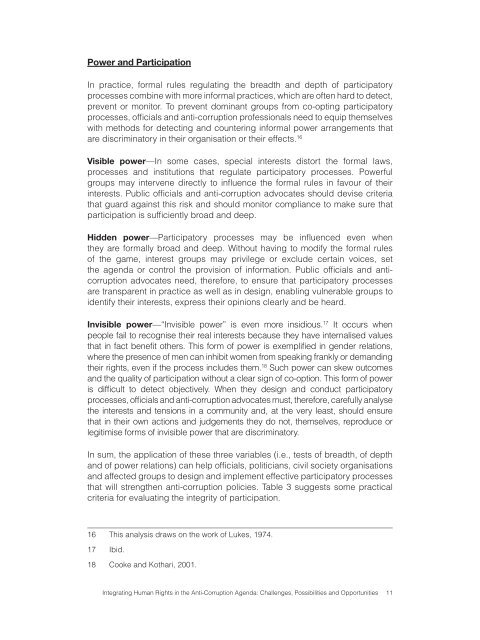Integrating Human Rights in the Anti-Corruption Agenda - The ICHRP
Integrating Human Rights in the Anti-Corruption Agenda - The ICHRP
Integrating Human Rights in the Anti-Corruption Agenda - The ICHRP
Create successful ePaper yourself
Turn your PDF publications into a flip-book with our unique Google optimized e-Paper software.
Power and Participation<br />
In practice, formal rules regulat<strong>in</strong>g <strong>the</strong> breadth and depth of participatory<br />
processes comb<strong>in</strong>e with more <strong>in</strong>formal practices, which are often hard to detect,<br />
prevent or monitor. To prevent dom<strong>in</strong>ant groups from co-opt<strong>in</strong>g participatory<br />
processes, officials and anti-corruption professionals need to equip <strong>the</strong>mselves<br />
with methods for detect<strong>in</strong>g and counter<strong>in</strong>g <strong>in</strong>formal power arrangements that<br />
are discrim<strong>in</strong>atory <strong>in</strong> <strong>the</strong>ir organisation or <strong>the</strong>ir effects. 16<br />
Visible power—In some cases, special <strong>in</strong>terests distort <strong>the</strong> formal laws,<br />
processes and <strong>in</strong>stitutions that regulate participatory processes. Powerful<br />
groups may <strong>in</strong>tervene directly to <strong>in</strong>fluence <strong>the</strong> formal rules <strong>in</strong> favour of <strong>the</strong>ir<br />
<strong>in</strong>terests. Public officials and anti-corruption advocates should devise criteria<br />
that guard aga<strong>in</strong>st this risk and should monitor compliance to make sure that<br />
participation is sufficiently broad and deep.<br />
Hidden power—Participatory processes may be <strong>in</strong>fluenced even when<br />
<strong>the</strong>y are formally broad and deep. Without hav<strong>in</strong>g to modify <strong>the</strong> formal rules<br />
of <strong>the</strong> game, <strong>in</strong>terest groups may privilege or exclude certa<strong>in</strong> voices, set<br />
<strong>the</strong> agenda or control <strong>the</strong> provision of <strong>in</strong>formation. Public officials and anticorruption<br />
advocates need, <strong>the</strong>refore, to ensure that participatory processes<br />
are transparent <strong>in</strong> practice as well as <strong>in</strong> design, enabl<strong>in</strong>g vulnerable groups to<br />
identify <strong>the</strong>ir <strong>in</strong>terests, express <strong>the</strong>ir op<strong>in</strong>ions clearly and be heard.<br />
Invisible power—“Invisible power” is even more <strong>in</strong>sidious. 17 It occurs when<br />
people fail to recognise <strong>the</strong>ir real <strong>in</strong>terests because <strong>the</strong>y have <strong>in</strong>ternalised values<br />
that <strong>in</strong> fact benefit o<strong>the</strong>rs. This form of power is exemplified <strong>in</strong> gender relations,<br />
where <strong>the</strong> presence of men can <strong>in</strong>hibit women from speak<strong>in</strong>g frankly or demand<strong>in</strong>g<br />
<strong>the</strong>ir rights, even if <strong>the</strong> process <strong>in</strong>cludes <strong>the</strong>m. 18 Such power can skew outcomes<br />
and <strong>the</strong> quality of participation without a clear sign of co-option. This form of power<br />
is difficult to detect objectively. When <strong>the</strong>y design and conduct participatory<br />
processes, officials and anti-corruption advocates must, <strong>the</strong>refore, carefully analyse<br />
<strong>the</strong> <strong>in</strong>terests and tensions <strong>in</strong> a community and, at <strong>the</strong> very least, should ensure<br />
that <strong>in</strong> <strong>the</strong>ir own actions and judgements <strong>the</strong>y do not, <strong>the</strong>mselves, reproduce or<br />
legitimise forms of <strong>in</strong>visible power that are discrim<strong>in</strong>atory.<br />
In sum, <strong>the</strong> application of <strong>the</strong>se three variables (i.e., tests of breadth, of depth<br />
and of power relations) can help officials, politicians, civil society organisations<br />
and affected groups to design and implement effective participatory processes<br />
that will streng<strong>the</strong>n anti-corruption policies. Table 3 suggests some practical<br />
criteria for evaluat<strong>in</strong>g <strong>the</strong> <strong>in</strong>tegrity of participation.<br />
16 This analysis draws on <strong>the</strong> work of Lukes, 1974.<br />
17 Ibid.<br />
18 Cooke and Kothari, 2001.<br />
<strong>Integrat<strong>in</strong>g</strong> <strong>Human</strong> <strong>Rights</strong> <strong>in</strong> <strong>the</strong> <strong>Anti</strong>-<strong>Corruption</strong> <strong>Agenda</strong>: Challenges, Possibilities and Opportunities 11

















